After leaving the very unusual labor of love that was Petersen's Rock Garden outside of Bend in central Oregon, Steven and I continued driving toward Salem, the state capital. Imagine living in a small town like Sisters in Oregon that proudly honors each of its high school graduates with banners along Main St.!
Rather than take the fastest and most direct route to Salem, we opted for Oregon's Scenic Byway via the Mackenzie Pass as that sounded far more interesting. It was soon apparent that a fire or infestation had laid waste to many of the trees in the Willamette National Forest. I shudder to think what this area looks like now with the recent fires that have raged throughout so much of Oregon.
No vehicles longer than 35 ft. were permitted on the road because it was so narrow and had many, many switchbacks.
I think this was likely Mt. Bachelor, a popular spot for skiers in the Cascade Mountain Range.
We stopped at a viewpoint to read about the 20 square mile area known as the Sea of Lava that changed the landscape 1,500 years ago. A sequence of three lava flows stretched to the west where the distant 6,872-ft-high Belknap Crater was the oldest.
At this same Windy Peak lookout, we caught this amazing view of Mt. Washington which was almost eight thousand feet high.
It was fun seeing swarms of monarch butterflies 'greet' me at the lookout!
As we continued up the pass, we came upon pockets of snow amid the downed trees. We figured the snow wouldn't last long in the 80 degree weather, though.
The Dee Wright Observatory was located at the 5,325-ft. summit of McKenzie Pass.

Hard to improve on the view at the Three Sisters Lookout!
Detroit Lake stretched for 22 miles along Hwy. 22, about 45 miles east of Salem. Steven and I were surprised that the highway wasn't 'dotted' on the AAA map to show its exceptional beauty.
We headed first to the 90-plus-acre Bush Homestead and Pasture Park, the centerpiece of Salem's park system. In 1860, Asahel Bush II and his wife purchased a 100-acre farm south of Salem that contained several large orchards, pastures of native grasses and wildflowers, and oak groves. After Bush's death in 1913, the family donated 57 acres of the property to the city which later bought the remaining acreage.
The Bush family's Italianate Victorian-style home took 18 years to complete and was lived in by members of the Bush family for 75 years.
Behind the home was the extensive rose garden that had more than 2,000 varieties! We didn't have time to see them all but it was very enjoyable wandering among the flowers.
Whoever had the responsibility of naming roses must have had a humorous streak as this one was called Voodoo!
Within steps of the house was the Bush Conservatory that was constructed for the family in 1882. As the restored conservatory was one of the oldest surviving glass greenhouses west of the Rockies, I was excited to enter it. The Bushes had visited conservatories at the Centennial Exposition in Philadelphia and at Golden Gate Park in San Francisco. As theirs was only the second west of the Mississippi, it became one of the gems in Salem. Its luster was also a significant feature in support of the listing of Bush House on the National Register of Historic Places.
I didn't know that summer heat can 'cook' even tropical plants. Protective methods used in the Bush's time are the same now being implemented. As the dry season begins, a coat of whitewash is applied to the glass exterior to shade the conservatory. Winter rains naturally dissolve the whitewash. For protection in hot weather, a venting system was installed that was state of the art in the 1930s and is still in use today!
According to the Oregon Historical Society, the Kalapuya people were relocated to the Grand Ronde Reservation in 1885. Their children were sent to reservation boarding schools, either the Indian Manual Labor Training School in Forest Grove or the Chemawa Indian School near Salem.
Our self-designed walking tour of Salem took us next to the Willamette Heritage Center, a 5.5 acre historic park that featured three historic homes, a church, and eight buildings from the Thomas Kay Woolen Mill that had been founded in 1889. It was probably just as well the center was closed as we wouldn't have been able to do it justice that late afternoon. Another place to add to our 'to see list' if we were to return! I was only able to take these next photos by sticking my camera through a fence as we walked toward the capitol - I have had to become quite adept over the years taking pictures through fences!
Before reaching the capitol itself, we wandered through the State Capitol State Park which was a delight in and of itself.
The monument commemorated the "labors and achievement of the ministers of the Gospel who, as circuit riders, became the friends, counselors, and evangels to the pioneers on every American frontier."
These Corinthian column segments originally were part of those that graced the west and east entrance portions of Oregon's first state house. The building was partially completed and occupied in 1873 but wasn't totally completed until 1892. The state house was destroyed by fire in 1935.
I found it pretty appalling that the grass hadn't been properly tended to on the grounds of the state house. It needed a good mowing pronto.
We paid our respects first at the Oregon Veterans' Medal of Honor Memorial on the grounds before walking to the state house.
I think both Steven and I were taken aback by the marble Art Deco-style State Capitol that was dedicated in 1938 and expanded in 1977 as it was so unlike any other state capitol we'd seen to date. The building was on the National Historic Register but I didn't know what features qualified for that distinction.
The building was topped with a 23-foot tall statue symbolizing Oregon's pioneers. I particularly would have loved to explore the inside of the state house as I'd read in the AAA tour book the rotunda featured four large Depression-era murals that depicted major events in Oregon's history. Another thing to add to our 'return to Salem if we can' list!
Some statues or monuments on each side of the building were covered. We figured that was done to possibly prevent damage from the wave of protests against police brutality and racial injustice around the country this summer.
The Parade of Animals was one of the most unusual sculptures we'd ever seen on the grounds of a state capitol and we should know as we've made it a point to discover as many state capitols as we can!
In a corner of the State Capitol State Park was the Oregon WW II Memorial with a 33-foot tall obelisk in the center. It was bordered by a black granite memorial wall. Seals set in the pavement honored the branches of the military who served so valiantly.
From the capitol we walked downtown toward Riverfront Park, a 23-acre park that was formerly occupied by warehouses and industrial activities. We found Salem to be a very walkable city and that was probably only increased by the number of streets that were either fully or partially blocked off to allow for increased outdoor dining.
The primary reason we'd come to Riverfront Park was to see its Riverfront Carousel that featured 42 brightly painted hand-carved horses, two wagons, a carousel band and, of course, a brass ring! Thought it was also closed, I could easily imagine its allure for children of all ages when I peered through the windows. That carousel ignited a desire to see more carousels on our pandemic road trips so stay tuned for more carousels to come!
We walked along the attractive riverfront to the Union St. Pedestrian Bridge.
We enjoyed the path so much we walked to the park's southern end to the Minto Island Bridge.
At 25 feet in diameter, the Eco Earth Globe was one of Oregon's and possibly the country's largest public works of art. What an ingenious way to turn a piece of industrial waste into something so beautiful!
The Statue of Liberty icon on the globe was dedicated to the men and women in the US military.
Next post: Portland's very impressive Vietnam Memorial and International Rose Test Garden.
Posted on September 26th, 2020, from Montgomery, Alabama, as we make our way back to the Florida Panhandle for two more weeks after exploring the Tampa area and then the Carolinas these last two plus weeks. As always, Steven and I hope that you will keep safe, stay healthy, and be connected to those you hold dear during these turbulent times.









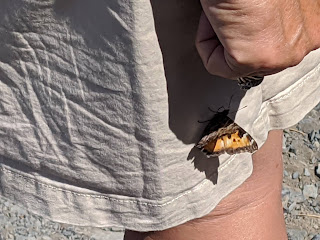





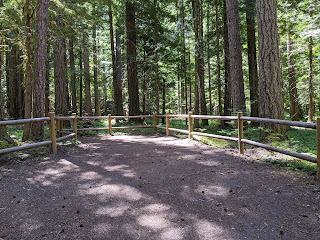







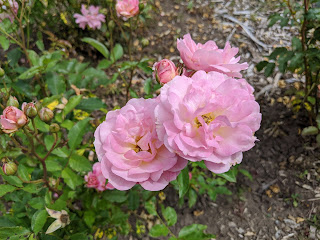


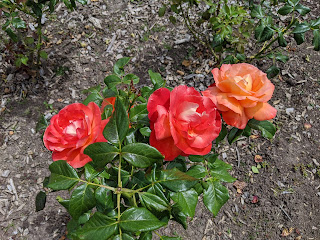



















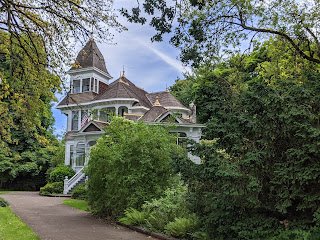



















































No comments:
Post a Comment